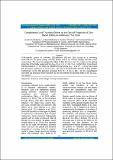| dc.contributor.author | Austine A Mulama , Julius M Mwabora , Andrew O Oduor and Cosmas M Muiva | |
| dc.date.accessioned | 2022-01-19T06:19:57Z | |
| dc.date.available | 2022-01-19T06:19:57Z | |
| dc.date.issued | 2018 | |
| dc.identifier.uri | https://repository.maseno.ac.ke/handle/123456789/4366 | |
| dc.description.abstract | Chalcogenide system of antimony (Sb)-selenium (Se)-zinc (Zn) system is a promising
semiconductor for phase change memory devices due to its thermal stability and low power
consumption. The study investigated the effect of film thickness and zinc content on the optical
properties of thermally evaporated Sb10Se90-xZnx (x = 0, 5, 10 & 15 at. %) thin films. It was found
that transmittance (T~ 85-40%) and optical band gap energy (Eopt ~ 1.60 eV – 1.22 eV) decreased
but absorption coefficient (α~0.840–2.031
104
cm–1
) increased with increase in zinc content.
Furthermore, as the film thickness increased from 53 5 nm to 286 10 nm, transmittance
decreased but band gap energy increased due to zinc defects and localized states in the Sb10Se90-
xZnx system | en_US |
| dc.publisher | AJOL | en_US |
| dc.subject | Selenium, phase change memory, localized states | en_US |
| dc.title | Compositional and Thickness Effects on the Optical Properties of Zinc– Doped Selenium–Antimony Thin Films | en_US |
| dc.type | Article | en_US |

